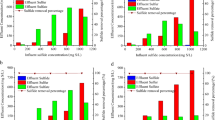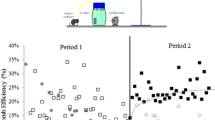Abstract
Sulfide and vanadium (V) are pollutants commonly found in wastewaters. A novel approach has been investigated using microbial fuel cell (MFC) technologies by employing sulfide and V(V) as electron donor and acceptor, respectively. This results in oxidizing sulfide and deoxidizing V(V) simultaneously. A series of operating parameters as initial concentration, conductivity, pH, external resistance were carefully examined. The results showed that these factors greatly affected the performance of the MFCs. The average removal rates of about 82.2 and 26.1% were achieved within 72 h operation for sulfide and V(V), respectively, which were accompanied by the maximum power density of about 614.1 mW m−2 under all tested conditions. The products generated during MFC operation could be deposited, resulting in removing sulfide and V(V) from wastewaters thoroughly.






Similar content being viewed by others
References
Zhao F, Rahunen N, Varcoe JR, Roberts AJ, Avignone-Rossa C, Thumser AE, Slade RCT (2008) Factors affecting the performance of microbial fuel cells for sulfur pollutants removal. Biosens Bioelectron (in press)
Greenman J, Gálvez A, Giusti L, Ieropoulos I (2009) Electricity from landfill leachate using microbial fuel cells: comparison with a biological aerated filter. Enzyme Microb Technol 44:112–119
Lu N, Zhou S, Zhuang L, Zhang L, Ni J (2009) Electricity generation from starch processing wastewater using microbial fuel cell technology. Biochem Eng J 43:246–251
Scott K, Murano C (2007) A study of a microbial fuel cell battery using manure sludge waste. J Chem Technol Biotechnol 82:809–817
Gonzalias AE, Kuschk P, Wiessner A, Jank M, Kästner M, Köser H (2007) Treatment of an artificial sulphide containing wastewater in subsurface horizontal flow laboratory-scale constructed wetlands. Ecol Eng 31:259–268
Rabaey K, Clauwaert P, Aelterman P, Verstraete W (2005) Tubular microbial fuel cells for efficient electricity generation. Environ Sci Technol 39:8077–8082
Rabaey K, VandeSompel K, Maignien L, Boon N, Aelterman P, Clauwaert P, Schamphelaire LD, Pham HT, Vermeulen J, Verhaege M, Lens P, Verstraete W (2006) Microbial fuel cells for sulfide removal. Environ Sci Technol 40:5218–5224
Zhao F, Rahunen N, Varcoe JR, Chandra A, Avignone-Rossa C, Thumser AE, Slade RCT (2008) Activated carbon cloth as anode for sulfate removal in a microbial fuel cell. Environ Sci Technol 42:4971–4976
Zhao F, Harnisch F, Schroder U, Scholz F, Bogdanoff P, Herrmann I (2006) Challenges and constraints of using oxygen cathodes in microbial fuel cells. Enviro Sci Technol 40:5193–5199
Hong SW, Chang IS, Choi YS, Kim BH, Chung TH (2008) Responses from freshwater sediment during electricity generation using microbial fuel cells. Bioprocess Biosyst Eng (in press)
Scott K, Murano C (2007) Microbial fuel cells utilising carbohydrates. J Chem Technol Biotechnol 82:92–100
Wang G, Huang L, Zhang Y (2008) Cathodic reduction of hexavalent chromium [Cr(VI)] coupled with electricity generation in microbial fuel cells. Biotechnol Lett 30:1959–1966
Jia YH, Tran HT, Kim DH, Oh SJ, Park DH, Zhang RH, Ahn DH (2008) Simultaneous organics removal and bio-electrochemical denitrification in microbial fuel cells. Bioprocess Biosyst Eng 31:315–321
Carpentier W, Sandra K, Smet ID, Brigé A, Smet LD, Beeumen JV (2003) Microbial reduction and precipitation of vanadium by Shewanella oneidensis. Appl Environ Microbiol 69:3636–3639
Lovley DR, Phillips EJP (1988) Novel mode of microbial energy metabolism: organism carbon oxidation coupled to dissimilatory reduction of iron and manganese. Appl Environ Microbiol 54:1472–1480
Cline JD (1969) Spectrophotometric determination of hydrogen sulphide in natural waters. Limnol Oceanogr 14:454–458
Safavi A, Nezhad MRH, Shams E (2000) Highly selective and sensitive kinetic spectrophotometric determination of vanadium (IV) in the presence of vanadium (V). Anal Chim Acta 409:283–289
Rabaey K, Verstraete W (2005) Microbial fuel cells: novel biotechnology for energy generation. Trends Biotechnol 23:291–298
Zuo Y, Maness PC, Logan BE (2006) Electricity production from steam-exploded corn stover biomass. Energy Fuels 20:1716–1721
Liu H, Cheng S, Logan BE (2005) Power generation in fed-batch microbial fuel cells as a function of ionic strength, temperature and reactor configuration. Environ Sci Technol 39:5488–5493
Gil GC, Chang IS, Kim BH, Kim M, Jang JK, Park HS, Kim HJ (2003) Operational parameters affecting the performance of a mediator-less microbial fuel cell. Biosens Bioelectron 18:327–334
Fan Y, Hu H, Liu H (2007) Sustainable power generation in microbial fuel cells using bicarbonate buffer and proton transfer mechanisms. Environ Sci Technol 41:8154–8158
Li Z, Zhang X, Lei L (2008) Electricity production during the treatment of real electroplating wastewater containing Cr6+ using microbial fuel cell. Process Biochem 43:1352–1358
Aelterman P, Versichele M, Marzorati M, Boon N, Verstraete W (2008) Loading rate and external resistance control the electricity generation of microbial fuel cells with different three-dimensional anodes. Bioresour Technol 99:8895–8902
Acknowledgments
Financial support is gratefully acknowledged from the National Natural Science Foundation of China (20877001). The authors are grateful to Dr. Zhen He from University of Southern California and Prof. Alistair Borthwick from University of Oxford for their kind help in paper organizing and English editing.
Author information
Authors and Affiliations
Corresponding author
Rights and permissions
About this article
Cite this article
Zhang, BG., Zhou, SG., Zhao, HZ. et al. Factors affecting the performance of microbial fuel cells for sulfide and vanadium (V) treatment. Bioprocess Biosyst Eng 33, 187–194 (2010). https://doi.org/10.1007/s00449-009-0312-2
Received:
Accepted:
Published:
Issue Date:
DOI: https://doi.org/10.1007/s00449-009-0312-2




